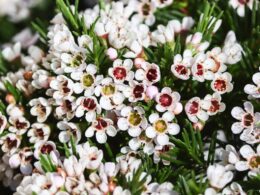What Is a Snake Plant? Characteristics and Origin
The snake plant flowers, just like other plants in its genus. Formerly, it was classified as Sansevieria trifasciata, and its current species name is Dracaena trifasciata. It’s a semi-succulent native to tropical West Africa. It gets its common name from its long, snake-like leaves, which are arranged in a rosette pattern. Some other names are:
- Saint George’s sword;
- mother-in-law’s tongue;
- viper’s bowstring hemp.
Its species name trifasciata means ‘three bundles,’ referring to how the leaves grow out of the basal rosette. The leaves are green with pale bands or stripes, and the edges are often tipped with red or yellow.
The snake plant is a low-maintenance plant that can tolerate neglect and poor growing conditions. It is an ideal choice for beginners or for people who don’t have a lot of time for garden maintenance. The snake plant is also known for its ability to purify air, making it a great choice for indoor growers.
When Does a Snake Plant Flower?
Snake plants are semi-succulents, which means they can store a bit of water in their leaves. They’re native to Africa and enjoy warm, dry climates. Because of this, they don’t often bloom indoors. If you want to see your snake plant bloom, you’ll need to mimic its natural habitat as much as possible.
When the requirements are met, snake plant flowers will typically appear once a year in the spring. The flowers will last a few weeks and might produce berries (which are toxic like the rest of the plant).
5 Steps to Make Your Snake Plant Flower
If you’re interested in seeing your snake plant bloom, there are a few things you can do to encourage it. They’re not guaranteed to work, and you may not have control over all of them. Still, if you’d like to try, here are 5 tips to get you started.
1. Provide Bright, Indirect Light
Snake plants grow best in bright, indirect light. If you live in a tropical-like climate, you can grow them outdoors in a shady spot, and if you’re growing snake plants indoors, place them in front of a sheer window.
Flowering takes a lot of energy, so snake plants need all the light they can get. If you don’t have access to bright sunlight, you can try using grow lights. Snake plants need 16 hours of light per day to encourage blooming. This is probably why most owners have never seen theirs flower!
2. Adjust the Amount of Watering
Water your snake plant when the soil is dry to the touch. The amount of water will depend on the size and type of pot you’re using. For example, snake plants in terracotta pots will need more water than those in plastic pots.
Be careful not to overwater your snake plant, or it will start to rot. Usually, twice a month is enough – it can store water just like succulents. It’s a good idea to check the moisture level before watering by sticking your finger into the soil. If it feels dry several inches below the surface, it’s time to water.
Some gardeners swear by this trick: if you want to make your snake plant flower, water them less often than usual. Withholding water will stress the plant and force it to bloom instead of producing leaves. However, don’t let the soil dry out completely, or you’ll damage the roots.
3. Give It a Small Dose of Fertilizer
You don’t need to fertilize snake plants often, as they’re slow-growing plants that prefer light, airy soil. In fact, over-fertilizing can be just as harmful as overwatering. However, sprinkling a small dose of phosphorus-high fertilizer once a year in spring may increase your plant’s chances of blooming.
4. Raise the Temperature a Bit
Snake plants like warm, dry climates. They thrive in USDA hardiness zones 9-11. If you live in a cold climate or keep your home on the cool side, you may need to raise the temperature to encourage blooming. The best temperature for snake plants is between 70 and 90 degrees Fahrenheit. You can try moving your plant closer to a heater or placing it in a sunnier spot.
5. Wait a Couple of Years
Finally, it’s important to be patient. Snake plants can take a few years to reach maturity and start blooming. If you’ve followed all the tips above and your snake plant still hasn’t bloomed, it doesn’t mean it never will.
It’s best not to repot the plant too often if you want it to bloom. Pot-bound plants will often redirect their energy from growing leaves to flowering. A bit of stress can be good for making your snake plant flower.
Do Snake Plant Flowers Have a Fragrance?
According to the few lucky owners who have seen their mother-in-law’s tongues bloom, snake plant flowers have a sweet scent. Their nectar trickles down their stems during the night. It can make a mess, but it also means you’ll smell the flowers from afar.
Can You Use Snake Plant Flowers in Bouquets and Arrangements?
Unfortunately, snake plant flowers don’t last long. If you cut them, they’ll wilt quickly, so it’s best to enjoy the flower stalks in their pots. Besides, their sticky nectar isn’t something you want all over your table.
Snake Plants Bloom Under the Right Conditions – if You’re Lucky
The snake plant flower is definitely a sight (and smell) to behold. If you’re patient and follow the tips above, you might be lucky enough to see your houseplant in all its glory. Just don’t forget to take pictures! Who knows, you might be the first one in your neighborhood with a blooming sansevieria.
Have you ever seen a snake plant flower? What did it look like? Let us know in the comments below!



















